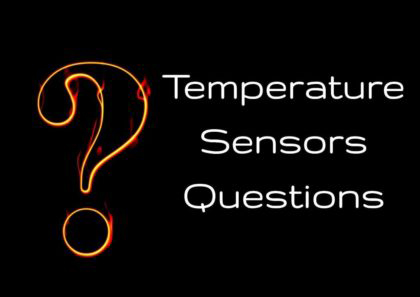Study the Temperature Sensors Questions and Answers for your interview preparation. This article focus on Thermocouple and Pyrometer Questions.
Thermocouple and Pyrometer

1. Define Seebeck effect?
When a pair of dissimilar metalsis joined together, emf is induced at the junction of the metals, this effect is called seebeck effect.
2. Define peltier effect.
When a pair of dissimilar metals are joined together, emf is induced at the junction of the metals If the metal is connected to an external circuit some amount of current is drawn, due to which the induced emf will be slightly altered.
3. What is thomson effect?
When a pair of dissimilar metals are joined together, emf is induced at the junction of the metals. If temperature gradient exist along either/ both of the metal, the junction emf may undergo an additional slight alteration called as Thomson effect.
4. What is thermocouple?
A temperature measuring device formed by connecting two dissimilar metals and is based on the principle of Seebeck effect , peltier effect and Thomson effect.
5.Say the effects that thermocouple is based on?
- Seebeck effect ,
- peltier effect and
- Thomson effect
6.What are the various types of thermocouple junctions?
- Reference junction (or) cold junction (or) standard junction And
- hot junction (or) measuring junction (or) desired temperature junction
7. What is thermopile?
A series of identical thermocouple connected together in a casing is called thermopile.
It is also Used for measuring average temperature.
8. Define law of homogeneous circuit?
An emf will not be induced in a circuit with a system consisting of homogeneous metal.
9. Define law of intermediate metals?
The net emf in the circuit remains unaltered if a third metal is introduced, provided the junctions formed by the third metal is at same temperature.
10.Define law of intermediate temperature.
The emf generated at the junction temperature T1& T3 is equal to the algebraic sum of emf generated at the junction in T1-T2 and T2-T3, where T2 lies between T1 &T2
11. Give few types of Thermocouple with composition and temperature range?
- J-type : Iron and constantan : -200 to 1000
- K type : chromel- alumel : -2000 to 1200
- T type : copper- constantan : -200 to 350
12. What are the compensating techniques used in thermocouple?
- Lead compensation,
- Reference junction compensation(ice bath compensation)
- Isothermal block compensation.
13. What is isothermal block.
A strip or a block where uniform temperature is maintained is called isothermal block.
14. Give some merits and demerits of thermocouple
Merits:
- wide temperature range,
- inexpensive,
- good reproducibility
Demerits:
- nonlinear response,
- need compensating circuits
15. What are the sources of error in thermocouple.
- Junction formed by Faulty soldering technique
- Thermocouple may be used outside their applicable range
- Faulty reference junction compensation may be employed
- Installation faults
- Usage of wrong type of thermocouple.
16. What are radiation methods of temperature measurement.
- Total radiation method and
- selective or partial radiation method
17. Define pyrometer.
Technique for measuring temperature without contact. It depends on the relation between temperature of heat body and electromagnetic radiation emitted by the black body.
18. Give the classification of pyrometer?
- Radiation pyrometer,
- Optical pyrometer,
- Selective / partial pyrometer,
- Two colour pyrometer
19. What are the uses of radiation pyrometer?
Used for very high temperature measurement 700 degc -3500 degc without the actual contact with the radiating body, Very high response
20. What is black body?
A body which absorbs all radiation without transmitting and radiation any is called black body. A black body radiates energy at all spectral wavelength at a maximum rate corresponding to its temperature.
21. What is grey body?
An object having emittance less than unity and constant at all wavelength is called grey body
22. Give some application of pyrometer?
Used for very high temperature measurement 700 degc -3500 degc
23. What are factors that affect the response of thermocouple.
Size or thickness of the thermocouple wires, Sheath material, protection tube and thermowell, Position /location of the thermocouple with respect to process
24. What is principle used in optical pyrometer.
Within the visible region a given wavelength has a fixed color and the energy of radiation is interpreted as intensity or brightness. Hence the brightness of the light of given color emitted by hot source, indicates the value of temperature.
25. Why protective sheath is used in thermocouple
Protecting the thermocouple metals from contamination and rusting. Preventing against oxidizing, sulphating and in molten baths. To with stand thermal and mechanical shocks.
26. Demerits of Optical Pyrometer ?
- It is based on an observer judging 2 colors to be the same.
- It requires direct line of sight to the object (or furnace) which the temperature is to be measured

